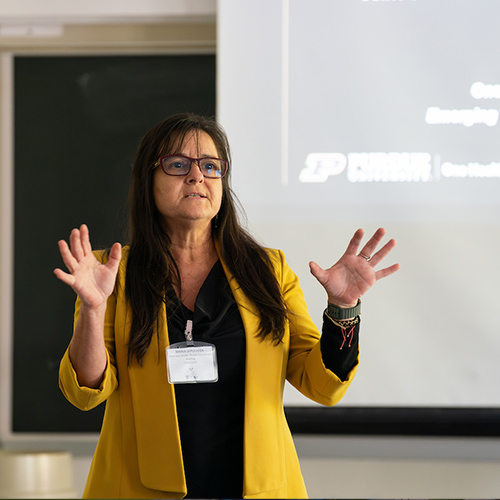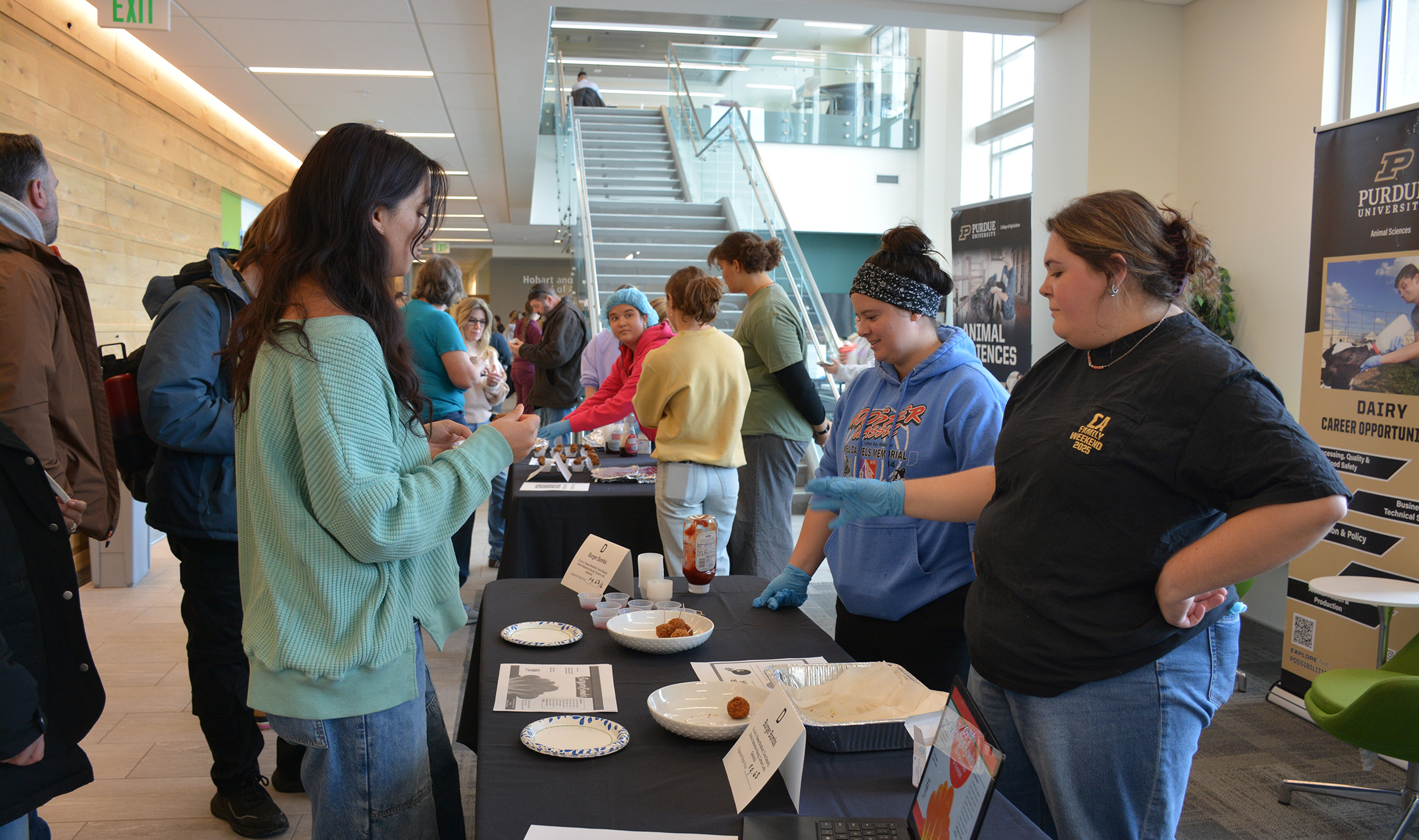ABE alumni drive hydraulic innovation at John Deere
The iconic green John Deere tractor is evolving with an exciting new option – a battery electric model with an innovative hydraulic system designed by a trio of Purdue University Agricultural and Biological Engineering (ABE) alumni.
Michael Holland (BSME ’05, MS agricultural engineering ’07, PhD agricultural engineering ’12), James Bartlett (BS agricultural engineering ’08) and Greg Long (BS agricultural engineering ’07, MS agricultural engineering ’09) are the minds behind the hydraulics on the prototype John Deere E-Power battery electric tractor. Powered by a decades-long connection built on shared academic foundations and practical engineering experience, the team was distinctively equipped to help design John Deere’s first electric tractor.
All three found their way to Purdue from farming backgrounds with a desire to use engineering to improve the tools of agriculture. Although Holland started in the School of Mechanical Engineering, he was drawn to ABE. Long and Bartlett both gravitated to machine systems, attracted by the hands-on learning environment and tight-knit community.
“I found the ABE building and fell in love with the culture of a small department,” recalled Long. “I come from a small town, so I felt at home there.”
As ABE students, they spent countless hours in labs and classes focused on fluid power, mechanical systems and control technologies. Gary Krutz’s introduction to hydraulic control systems course served as a gateway to the then new Maha Fluid Power Research Center, where they were exposed to cutting-edge hydraulics research and experimental equipment.
All three credit ABE professors, such as Krutz, John Lumkes and Monika Ivantysynova, with shaping their technical understanding and fostering their passion for fluid power engineering. Years later, they found themselves returning to class notes while designing the John Deere battery-electric tractor’s hydraulic system.
“To a certain extent, physics doesn’t change,” Long said. “If you can wrap your head around the concepts and get real-world experience with it early on, it stays with you for the rest of your life.”
In addition to rigorous academics, some of the engineers’ most formative experiences happened outside the classroom. One example, the annual International Quarter Scale Tractor Student Design Competition, run by the American Society of Agricultural and Biological Engineers (ASABE), gives students the opportunity to design and build a one-of-a-kind tractor from the ground up.
Their years on the Purdue quarter scale team also instilled both engineering rigor and team trust. It taught them important lessons in project management. They were responsible for everything from development and assembly to fundraising and marketing – on top of their already full courseloads.
“It’s a huge life lesson packed into a ‘little’ design competition,” explained Bartlett. “It’s so much more than a quarter scale tractor."
Holland and Bartlett collaborated on quarter scale tractors in 2005 and 2006, but the standout entry they recall came when Long joined the team in 2007. That year’s rules allowed multiple engines, so Long and his colleagues entered a tractor with six engines, all stacked in a pyramid. They won the pulling category and finished second overall.
“Quarter scale tractors are 100 percent prototype,” noted Holland. “The beauty of the competition is it’s an opportunity to take technology and design risks.”
The skills they built during the quarter scale competition proved invaluable while developing the hydraulics system for the new John Deere E-Power tractor. As the lead hydraulic engineer, Holland established the overall architecture and brought in Bartlett and Long to turn the concept into reality.
“No matter what’s powering the transmission, you’re really just converting energy to a form of useful work,” Bartlett said. “Purdue gave us the background in different mechanisms that we apply to our work now.”
Their shared experience allowed them to communicate efficiently, trust each other’s instincts and engineer innovative, field-ready solutions. The result of those efforts is a tractor that is energetically efficient while still delivering the performance users expect from their equipment.
“The challenge was to integrate new technology with practical applications,” Holland pointed out. “At the end of the day, the farmer has to get in the tractor and do the work.”
Even years into their professional careers, the three engineers remain closely connected to Purdue ABE. They reconnect regularly with other alumni at the quarter scale competition in Peoria, IL, which Holland chaired this year. Bartlett has volunteered in past years as a judge, giving entrants valuable feedback on their work.
Purdue ABE offered this team’s members more than the top ranked undergraduate and graduate agricultural engineering programs in the country. The department fostered the camaraderie, shared purpose and hands-on skills that still define their work today.
Long credits the success of the project to their experiences at Purdue.
“ABE and Purdue gave us the ability to build strong relationships from the beginning,” he reflected. “We trust each other. Without that, I don’t think we could have achieved what we did.”
Decades after graduation, this team’s contributions to John Deere prove that a small team with deep shared roots can drive big change – one hydraulic line at a time.





